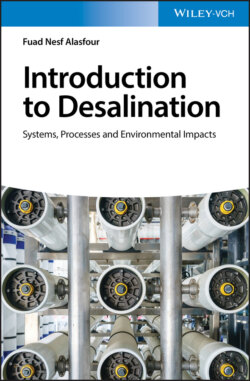Читать книгу Introduction to Desalination - Fuad Nesf Alasfour - Страница 15
1.4.1 Thermal Desalination System
ОглавлениеThere are several mature and reliable thermal desalination systems that are used today, and the two most conventional thermal (distillation) ones are:
1 MEE, where feed is heated, thus it evaporates via boiling process, then vapor is condensed after been screened through screen (demister) as potable water.
2 MSF, where feed is evaporated via flashing process due to sudden drop in pressure, then vapor is condensed after been screened through screen (demister) as potable water.
In addition to MEE and MSF, there are several types of thermal desalination systems that are used under specific conditions such as thermal vapor compression (TVC), mechanical vapor compression (MVC), and mechanical vapor recompression (MVR).
In general, thermal desalination systems are considered as an “old conventional” types, and they are characterized with simplicity in design and operation and even in maintenance. They have the ability to operate with feed salinity ranges from 20 000 to 100 000 ppm, the SEC varies from 4 to 6 kWh/m3 in addition to steam cost, and at the same time thermal desalination can produce high capacity of desalted water with high water purity (low TDS). As per processes, feedwater in thermal system desalination was subjected to their main progressive processes:
1 Heating: Where feed is heated via steam (thermal load) in first stage or by other type of energy source using its latent heat (hfg).
2 Evaporation: Feed is evaporated through feed phase change from liquid to vapor within the stages via boiling in case of MEE or via flashing in case of MSF.
3 Condensation: Freshwater vapor is condensed as potable water via heat exchanger (condenser).
The advantages and disadvantages of thermal system are presented.
Advantages of thermal distillation processes:
1 Suitable to treat high salinity feedwater such as seawaters.
2 Reliable and rigid system.
3 Require minimal conventional pretreatment for feedwater.
4 Capacity to use low waste thermal heat (low grade) from power plants to save energy.
5 Economical system if a heat source is available.
6 Easy in maintenance.
Disadvantages of thermal distillation:
1 The amount of water production depends on feed thermo‐physical properties (Tf, xf, …).
2 Tube scaling (CaSO4).
3 High value of SEC specially at elevated values of thermal performance.
